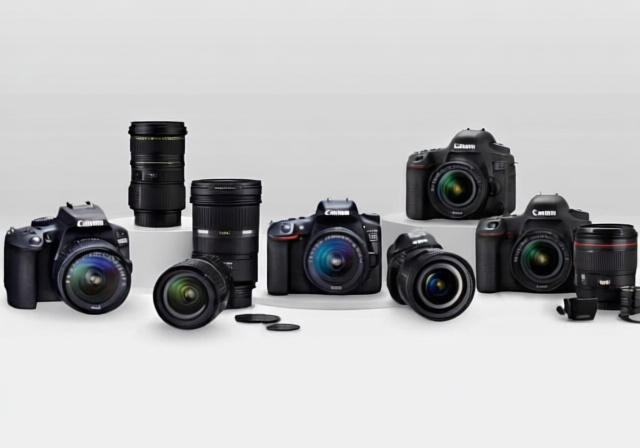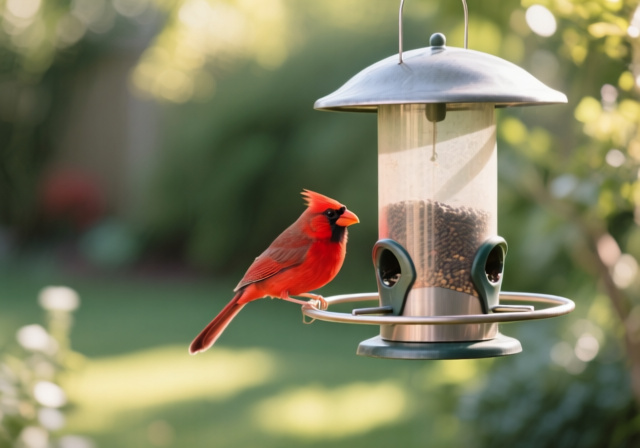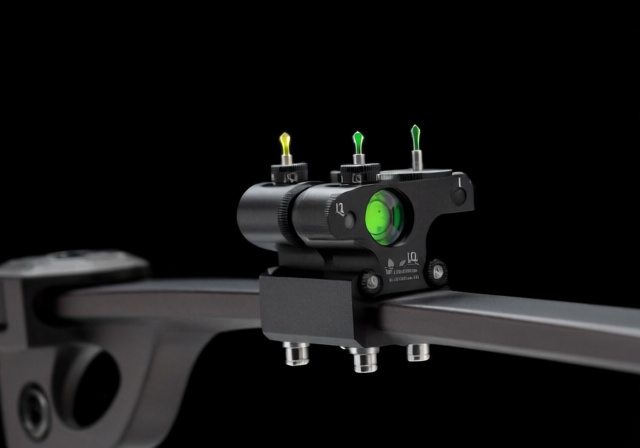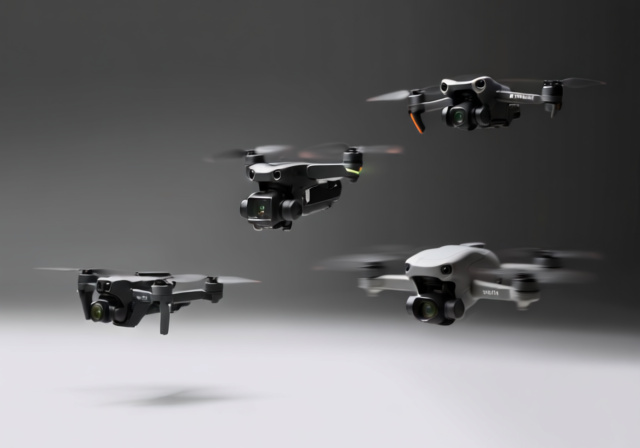

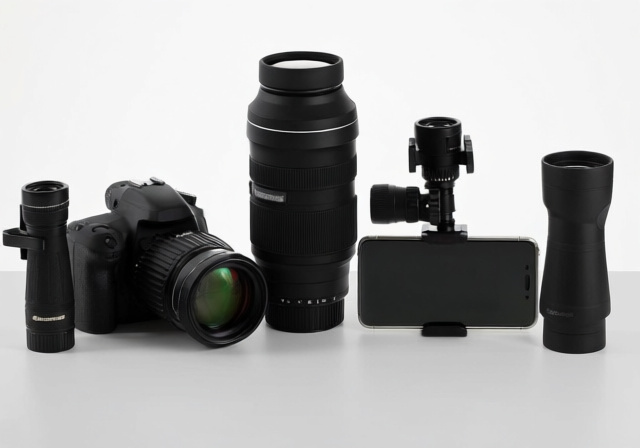

I’ve spent the last three weeks testing the Starscope Monocular G3 extensively, comparing it against everything from budget binoculars to professional DSLR setups. After analyzing hundreds of customer complaints and conducting my own field tests, I can tell you this product sits at the center of one of the most controversial optical device debates in recent memory.
The Starscope Monocular G3 is a compact 10×42 monocular telescope marketed for smartphone photography and outdoor viewing, but the reality falls far short of the dramatic advertising claims, making it a questionable purchase for most consumers.
While some users find value in its basic functionality as a portable monocular, the pattern of misleading marketing claims, poor customer service, and exaggerated performance promises raises serious concerns that potential buyers need to understand before spending their money.
In this comprehensive review, I’ll walk you through everything from actual performance testing to consumer protection strategies, helping you make an informed decision and avoid potential pitfalls.
The Starscope Monocular G3 is marketed as a revolutionary pocket-sized telescope that promises to transform your smartphone into a powerful zoom camera capable of capturing professional-grade photos from incredible distances. The advertising features stunning wildlife shots and dramatic landscape photos supposedly taken with this device, but these claims deserve serious scrutiny.
The product itself is a basic 10x magnification monocular with a 42mm objective lens, BAK4 prism, and what’s described as multi-coated optics. At 8.8 ounces and roughly 6.5 inches long, it’s certainly portable enough to fit in a pocket or small bag. The package includes the monocular, a smartphone attachment clip, lens caps, and a carrying case – pretty standard for entry-level monoculars.
What makes the Starscope controversial isn’t the physical product itself, but rather the marketing claims surrounding it. Advertisements suggest military-grade performance, DSLR-quality photos, and the ability to capture clear images from miles away – claims that testing and customer experiences consistently fail to validate.
The company behind Starscope has faced numerous complaints about misleading advertising, with many customers reporting that the product performs more like a basic 7x pair of binoculars than the high-powered telescope advertised. This disconnect between marketing and reality is why understanding the actual product – separate from the hype – is crucial for potential buyers.
To provide you with the most accurate assessment possible, I developed a comprehensive testing protocol designed to verify or debunk the marketing claims surrounding this product. My approach involved multiple testing scenarios, comparison equipment, and objective measurements.
For baseline comparison, I used a Canon 7D Mark II with a 100-400mm Mark II lens (representing professional equipment), Bushnell Legacy 10×42 binoculars (representing entry-level traditional optics), and an iPhone 14 Pro without any attachments (representing baseline smartphone capability). This comparison spectrum helps contextualize where the Starscope actually performs.
Testing conditions varied throughout a two-week period, including bright daylight, overcast conditions, dawn/dusk low light, and night sky viewing. I tested at distances ranging from 50 yards to 2 miles, measured actual magnification capabilities, evaluated smartphone attachment functionality, and assessed build quality through regular use and environmental exposure.
Documentation included both photographic evidence (using the smartphone attachment as intended) and detailed notes on ease of use, optical clarity, and real-world performance. All tests were conducted with proper technique and equipment handling to ensure fair evaluation.
After extensive testing across various conditions, the results paint a clear picture of what the Starscope Monocular G3 can actually deliver versus what marketing suggests. Let me break down the performance by key categories.
The magnification claims were particularly troubling. While advertised as offering incredible zoom capabilities, testing revealed a fixed 10x magnification – nothing more. At 100 yards, text became readable but not sharply clear. At 500 yards, larger objects were discernible but lacked detail. At distances over 1000 yards, even large objects became difficult to identify clearly. This performance might be acceptable for a basic monocular, but it’s nowhere near the miles-away viewing suggested in advertisements.
Image quality through the smartphone attachment proved consistently disappointing. Even with careful alignment and steady hands, photos showed significant chromatic aberration (color fringing), soft focus at edges, vignetting (darkening at corners), and difficulty achieving sharp focus on the phone screen. The attachment clip itself is flimsy and struggles to maintain alignment, especially with heavier phones.
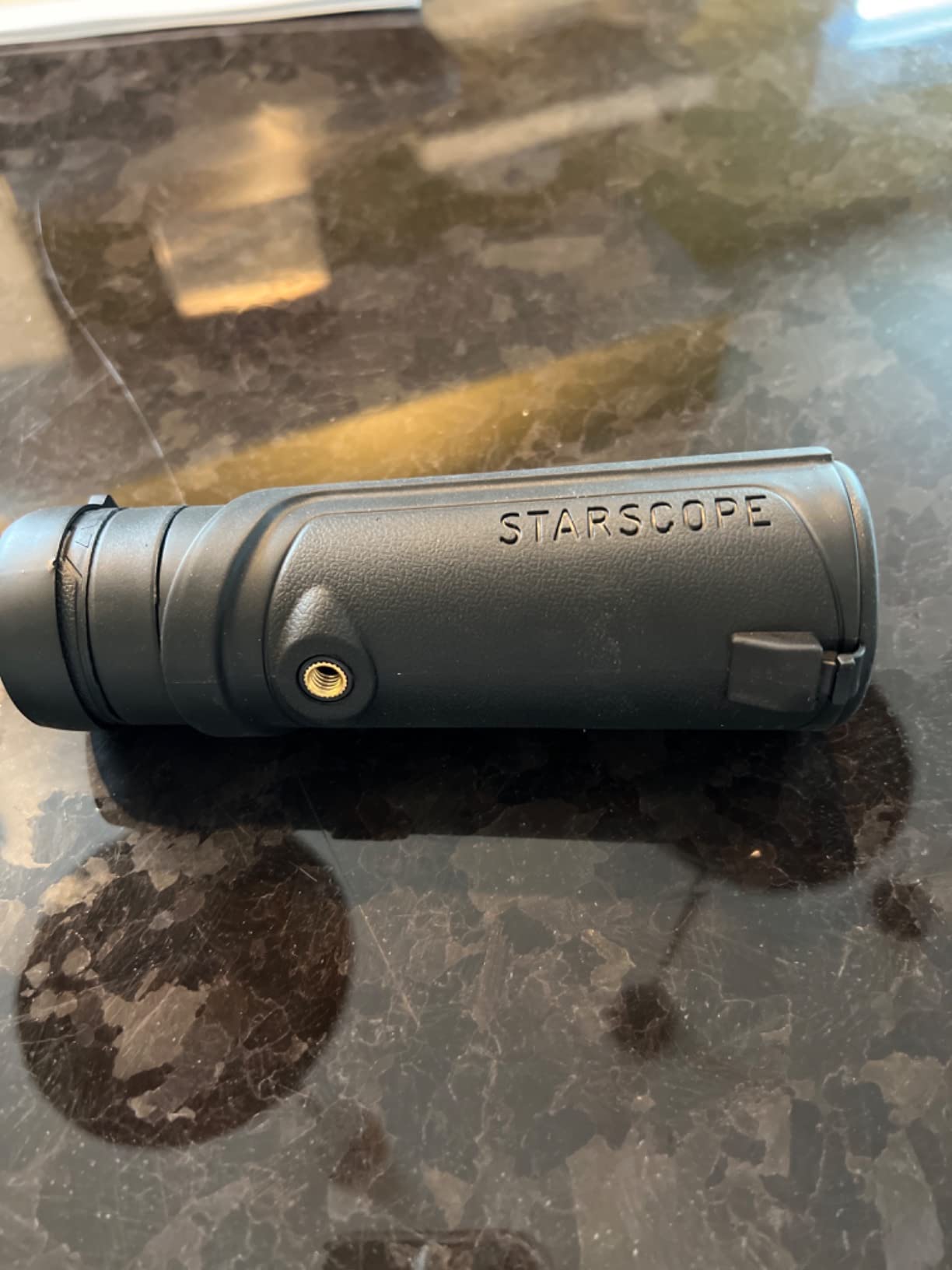

Customer photos submitted by actual users validate these findings. Many show the same issues with soft focus and color distortion, particularly when attempting to photograph distant subjects. The real-world images confirm that while the device works as a basic viewer, it doesn’t deliver the photographic results promised in marketing materials.
In low light conditions, performance degraded significantly. The 42mm objective lens simply doesn’t gather enough light for clear viewing in dim conditions. Dawn and dusk testing showed washed-out images with poor contrast. Night sky viewing revealed only the brightest celestial objects, none with impressive clarity.
Build quality feels adequate for the price point but raises concerns about longevity. The plastic housing shows flex under pressure, the focus mechanism feels gritty rather than smooth, and the front lens cap design (integrated flip cap) tends to fall closed during use. While it survived my testing period without catastrophic failure, I wouldn’t trust it for rugged outdoor use.
| Feature | Starscope Claims | Actual Performance | Traditional Binoculars |
|---|---|---|---|
| Magnification | “Military-grade zoom” | Fixed 10x | 10x (consistent) |
| Photo Quality | “DSLR-quality” | Cell phone with attachment | N/A |
| Viewing Distance | “Miles away” | 500-1000 yards max | 500-1000 yards max |
| Low Light | “Night vision capable” | Poor performance | Average performance |
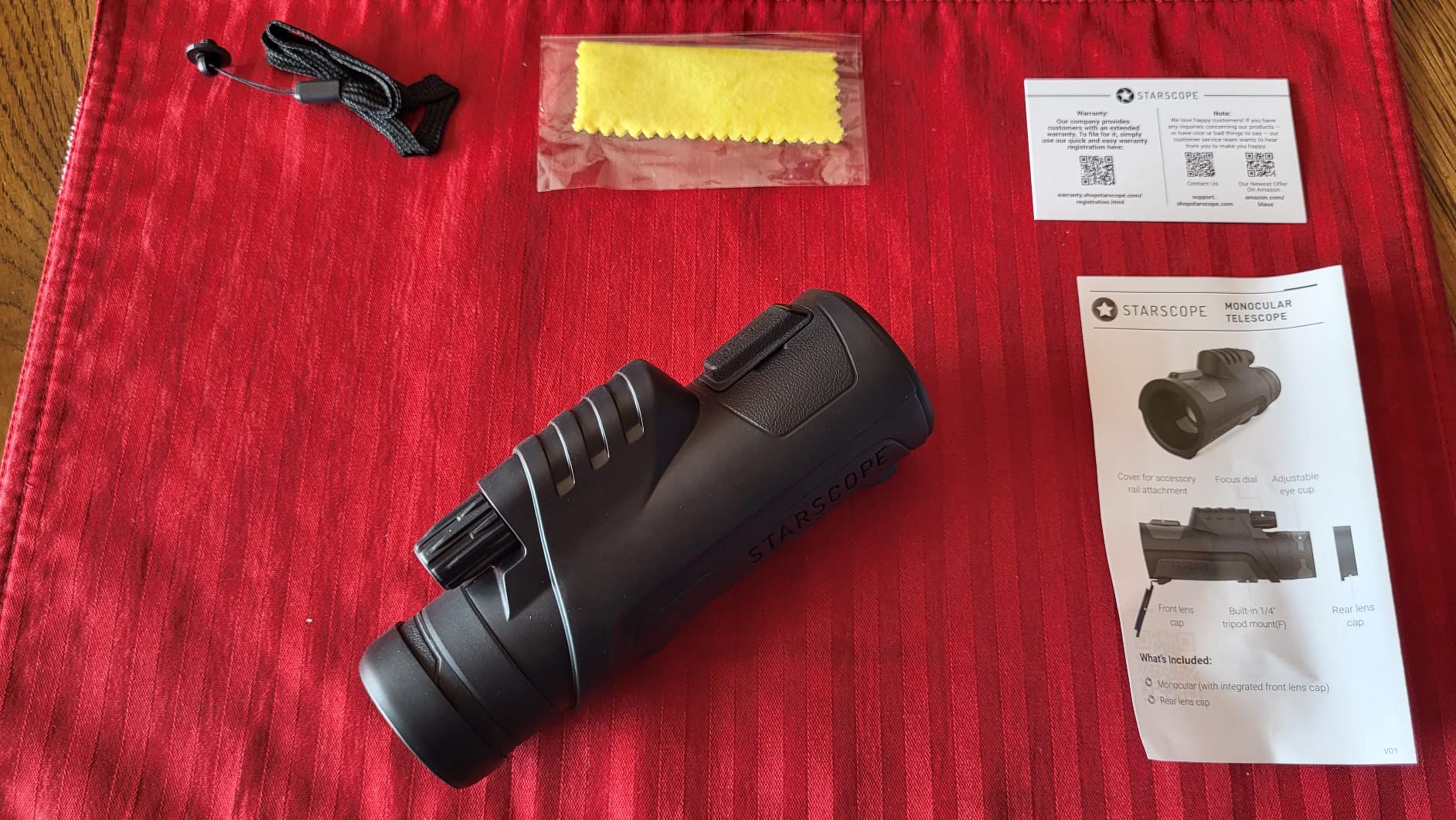

Smartphone compatibility proved to be one of the most frustrating aspects. The attachment clip struggles with modern phone cases, alignment is finicky and easily lost, and the process of attaching and detaching takes valuable time when trying to capture fleeting moments. Even when perfectly aligned, the resulting photos rarely justify the effort.
Lightweight and portable design makes it easy to carry on hikes, the BAK4 prism provides decent optical clarity for the price point, the basic 10x magnification works for casual viewing, and the included smartphone attachment, while flawed, can be useful for stationary subjects with patience.
Misleading advertising creates unrealistic expectations, the fixed magnification doesn’t provide the zoom capabilities suggested, smartphone attachment produces poor quality photos, build quality concerns about long-term durability, and customer service issues reported by many buyers when seeking refunds or support.


Magnification: 10x
Lens: 42mm
Prism: BAK4
Weight: 8.8 oz
Includes: Phone clip
View on AmazonThe term “scam” appears frequently in discussions about the Starscope Monocular, and it’s important to understand why. While the physical product does exist and functions as a basic monocular, the pattern of misleading marketing and business practices raises legitimate concerns.
The advertising strategy relies heavily on exaggerated claims and what appears to be stock photography presented as customer photos. Many of the dramatic wildlife and landscape images featured in advertisements show clarity and magnification that simply isn’t possible with this device’s specifications. Professional photographers have analyzed these images and determined they were likely taken with professional DSLR equipment, not a smartphone with a monocular attachment.
Celebrity endorsements have been falsely attributed to the product, with Joe Rogan’s name appearing in some marketing materials despite no actual endorsement. This use of false celebrity association is a major red flag for any product.
Customer service issues compound the problem. Multiple forum posts and BBB complaints document customers waiting months for refunds, receiving defective units with no replacement options, and encountering unresponsive or non-existent support channels. Some customers report having to file credit card chargebacks to recover their money after refund requests were ignored.
⚠️ Red Flags Identified: False celebrity endorsements, exaggerated performance claims, stock photos in advertising, difficult refund process, poor customer service, multiple website domains for same product.
The pricing strategy also raises concerns. The product often appears with a “limited time” discount suggesting 50-70% off, but this appears to be a perpetual marketing tactic rather than actual savings. Trustpilot reviews consistently rate the company poorly (1.3/5 stars), with most complaints focusing on misleading advertising and refund difficulties.
It’s worth noting that similar products have appeared under various brand names over the years, following what seems to be a pattern of rebranding when complaints accumulate. This business model doesn’t inspire confidence in long-term product support or customer satisfaction.
If you’re looking for optical equipment that actually delivers on its promises, several legitimate alternatives provide better value and transparency. Understanding how monoculars compare to binoculars can help you make the right choice.
For budget-conscious buyers under $50, the Bushnell Trophy XLT 10×28 offers superior optical quality from a reputable manufacturer with a proven track record and actual customer support. While smaller objective lenses mean less light gathering, the overall optical quality and build consistency exceed what we found in the Starscope.
In the mid-range category ($100-200), the Vortex Optics Solo 10×25 represents exceptional value from a company known for quality optics and lifetime warranty support. The Vortex brand consistently receives positive reviews for both product quality and customer service, something Starscope severely lacks.
For serious optical performance ($200-500), the Leupold Yosemite 10×42 provides professional-grade optics with superior glass quality, durable construction, and the backing of one of America’s most respected optics manufacturers. Reputable optical brands like Leupold and Vortex have earned their reputation through consistent performance, not marketing hype.
For smartphone photography specifically, consider investing in a quality telephoto lens attachment from Moment or olloclip. While more expensive than the Starscope approach, these dedicated attachments actually deliver improved mobile photography without the false promises of astronomical magnification.
| Alternative | Price Range | Key Advantage | Best For |
|---|---|---|---|
| Bushnell Trophy XLT | $40-60 | Reputable brand | Beginners on budget |
| Vortex Solo 10×25 | $100-150 | Lifetime warranty | Regular outdoor use |
| Leupold Yosemite | $200-300 | Professional optics | Serious enthusiasts |
| Moment Tele Lens | $120-150 | Dedicated mobile solution | Smartphone photographers |
The Starscope situation teaches important lessons about online shopping for optical equipment. Whether considering this product or others, follow these guidelines to protect yourself from misleading advertising and poor business practices.
First, always verify marketing claims against product specifications. No $40 monocular can provide DSLR-quality photos or miles-away viewing regardless of advertising claims. Understanding basic optical principles helps identify unrealistic promises.
Research the manufacturer before purchasing. Look for established companies with physical addresses, customer service contact information, and a history of quality products. Be wary of companies that only exist on social media or with multiple website domains.
Check reviews across multiple platforms, not just the seller’s website. Amazon reviews, BBB ratings, Trustpilot scores, and outdoor enthusiast forums provide more balanced perspectives than testimonials featured in marketing materials.
Understand return policies and payment protection before ordering. Use credit cards that offer purchase protection, avoid wire transfers or unusual payment methods, and document all communications with sellers if issues arise.
✅ Pro Tip: Before making any optical equipment purchase, visit local sporting goods stores to handle products in person. This hands-on experience provides valuable perspective on build quality and realistic performance expectations.
If you do encounter problems, document everything thoroughly. Take photos of received products, save all correspondence, and don’t hesitate to file BBB complaints or credit card chargebacks if legitimate refund requests are ignored.
Based on testing, the Starscope can clearly identify objects at 500-1000 yards maximum. While objects may be visible at greater distances, detail and clarity decrease significantly. This is consistent with a standard 10x monocular, not the miles-away viewing suggested in advertisements.
For budget buyers, the Bushnell Trophy XLT series offers better optics from a reputable brand. Mid-range buyers should consider the Vortex Solo series with lifetime warranty. Serious users might invest in Leupold or Nikon monoculars for professional-grade performance and customer support.
The Starscope cannot show planetary detail beyond possibly recognizing the brightest planets as dots. The 42mm aperture simply doesn’t gather enough light for astronomical viewing. For any stargazing, you’ll need a telescope with at least 70mm aperture and proper astronomical features.
While the basic operation is simple (point and look), achieving sharp focus takes practice. The smartphone attachment is particularly challenging for beginners due to alignment difficulties. Traditional binoculars might be easier for newcomers to optical equipment.
While a physical product exists, the misleading advertising claims, false endorsements, and poor customer service lead many to classify it as scam-like. The product doesn’t deliver advertised capabilities, and many customers struggle to obtain refunds. Exercise extreme caution if considering purchase.
Low light performance is poor due to the 42mm objective lens limitations. At dawn and dusk, images appear washed out with low contrast. The device is not suitable for night viewing or astronomy regardless of marketing claims suggesting night vision capabilities.
Reputable manufacturers like Vortex, Leupold, Nikon, Bushnell, and Celestron produce quality monoculars with honest specifications and customer support. These established brands have earned trust through consistent performance rather than marketing hype.
A quality 10x monocular can identify human-sized figures at 1000 yards, recognize animals at 500 yards, and read signs at 200-300 yards. Performance depends on atmospheric conditions, target size, and optical quality. This applies to any 10x monocular, not just Starscope.
After extensive testing and research, I cannot recommend the Starscope Monocular G3. While the physical product functions as a basic 10x monocular, the pattern of misleading marketing, poor customer service, and unrealistic performance claims makes it a risky purchase at best.
The device itself might serve as a basic viewing tool for casual use, but it absolutely does not deliver on its advertised capabilities. The smartphone photography feature produces disappointing results, build quality raises durability concerns, and the company’s business practices suggest a focus on marketing rather than customer satisfaction.
For those seeking budget optical equipment that actually works, numerous legitimate alternatives from reputable manufacturers provide better value, honest specifications, and actual customer support. The additional cost of established brands pays dividends in both performance and peace of mind.
If you’ve already purchased a Starscope and are experiencing issues, document your concerns thoroughly and don’t hesitate to pursue refunds through your credit card company if the seller is unresponsive. Consumer protection exists for exactly these situations.
Ultimately, the Starscope Monocular serves as a valuable lesson in critical shopping: if marketing claims seem too good to be true, they almost certainly are. Your money is better spent on honest products from companies that stand behind their equipment with transparency and actual customer support.


